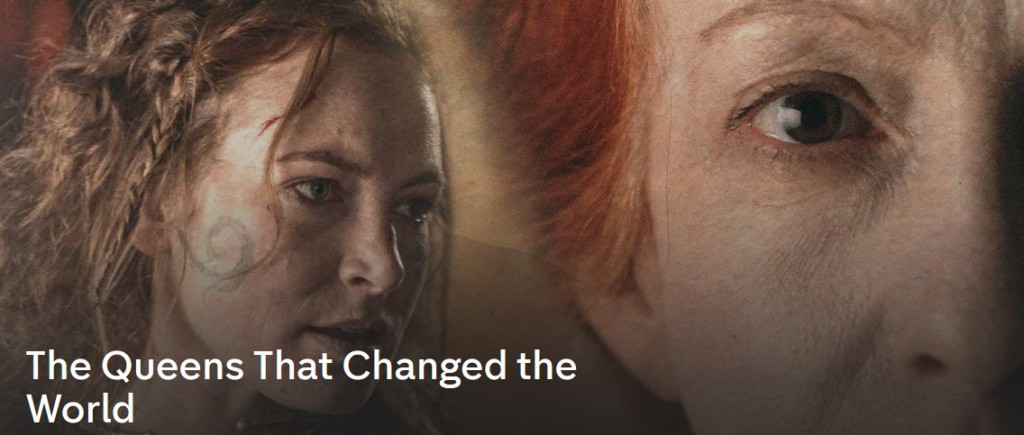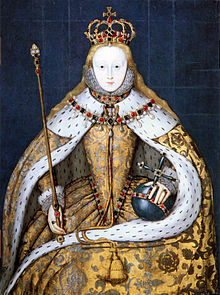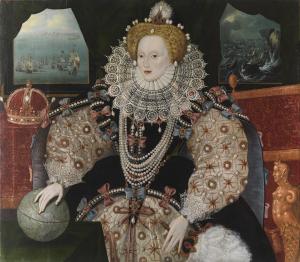
Below are notes I took while watching the Channel 4 documentary ‘The Queens That Changed the World’, episode 1, which was on Elizabeth I. Future episodes will be on Queen Anne, Queen Victoria, Hatshepsut, Eleanor of Aquitaine and Boudica, all of which I will add to this blog as I watch the episodes. I enjoyed this episode, with notable historians including Tracy Borman and Estella Paranque.
Across centuries and around the world women ruled kingdoms and built empires.
Discover real stories of 6 iconic queens.
History’s most important female monarchs.
Find out how they overcome prejudices of their times, and challenges facing reigns.
How they changed their world and ours.
9 August 1588 Elizabeth I about to make most important speech of her life.
“Undoubtedly the greatest danger Elizabeth ever faced” – Tracy Borman.
120 Spanish ships on their way to invade England remove Elizabeth from throne.
Defining moment in female sovereignty.
50 years earlier idea Elizabeth would be warrior queen was unimaginable.
May 1536 Elizabeth’s mother, Anne Boleyn, imprisoned in Tower of London.
Elizabeth had difficult childhood, and only just managed to escape with her life.
Anne Boleyn accused of incest with 5 men including her own brother, but real crime was failure to give Henry VIII a male heir.
1533 Anne Boleyn gave birth to Elizabeth; crushing disappointment to Henry VIII.
Not an age when England accepted queens.
Anne Boleyn doted on daughter, having her on cushion beside her rather than in nursery.
Some suggestion Anne wanted to breastfeed daughter rather than giving her to wet nurse.
On king’s orders Anne Boleyn beheaded, Elizabeth not quite 3 years old.
Hatfield Palace 20 miles north of London – Elizabeth brought here at 3 months old and where she grew up.
Probably at Hatfield when she knew her mother had died.
Asked why she was now being called Lady Elizabeth rather than Princess Elizabeth – bastardised.
Feeling insecure about own safety and security – if mother beheaded what might happen to her?
Aware that people didn’t expect any good of her because of who her mother was “little whore” compared to mother being “great whore”.
Set out to promote image of purity and soberness – morally beyond reproach.
Elizabeth developed survival strategy to never say what she really thought.
Estelle Paranque – Elizabeth pretended to be what they wanted her to be.
November 1558 Elizabeth sitting under oak tree at Hatfield when she learns half-sister Mary I has died, and she is queen.
Elizabeth last in line of sibling succession – preceded by Edward VI and Mary I.
Supposedly either eating an apple or reading a book when she learned she was queen.
“It is the lord’s doing and it is marvellous in our eyes”.
Keen to assert authority and 3 days after ascending to throne she called privy council at Hatfield – asks councillors to commit to her and her reign.
Inherited kingdom in trouble – brother instituted unpopular prayer book which led to uprising and allowed enclosure of land which also led to rebellion.
Mary’s reign brief and disastrous, tried to re-institute Catholic religion.
Elizabeth needed to reconstruct nation – huge job.
Overwhelming, scary, and few people thought that she would succeed. Women considered second class citizens in every respect.
Rule of women against God’s natural order; requires accidents for men to die.
Elizabeth would prove world wrong.
Estelle Paranque “Elizabeth is the definition of a bad-ass queen”.
Wouldn’t be dominated by anyone.
15 January 1559 2 months after ascending to throne, coronation of Elizabeth I.
Long-established tradition that monarch would set out for coronation from Tower of London and procession headed for Westminster Abbey.
Conflicting emotions at being back in the Tower of London but returned in triumph as Queen.
Travelled in litter of yellow and gold and people came out to see her.
Anne Boleyn’s name hardly mentioned since execution, but Elizabeth celebrated her with life-size model of her on procession route – proud to be her daughter.
20 kings of England crowned before Elizabeth.
Religious divisions needed to be tackled in order for her to keep throne.
Half her subjects think she has no right to be Queen – England divided since Break with Rome when Henry VIII broke with Rome to marry Anne Boleyn.
Country Protestant under Edward VI, but Catholic under Mary I.
Mary I publicly burned anyone who didn’t adhere to Catholic faith.
During coronation, Elizabeth I gave bishop a book and gave him a steely look – wanted Gospel read once in Latin and once in England. Never done at a coronation before.
Expected Elizabeth I would take revenge against Catholics for Mary I’s Catholic persecution.

Elizabeth undoubtedly Protestant in her heart but was a pragmatist and wanted unity and an end to deep-seated divisions.
Aim to unite warring factions in England.
Language you can pray in was point of contention between Catholics and Protestants – signalling space for both kinds of worship.
Won’t make windows into men’s souls; attend Church of England and outwardly conform, you can believe what you want in private.
4 months after coronation Elizabeth’s religious settlement becomes law.
Probably one of her greatest achievements – Tracy Borman.
Huge moment in the history of the monarchy and without it we wouldn’t’ have Church of England as it is today.
1563 Elizabeth on throne for 5 years, single and uses relationship status to enhance power on world stage through marriage.
Mounting pressure for her to marry.
Full length portrait commissioned and sent to eligible bachelors in Europe.
Flowers encouraged messages and could say things to people, abundance of flowers behind Elizabeth in portrait show her fertile and ready to reproduce.
Elizabeth holds carnation, symbol of matrimony.
In reality Elizabeth hesitant to agree to match – father had mother beheaded so probably had view of marriage as being dangerous.
After Anne Boleyn’s execution, Henry VIII marries Jane Seymour who died in childbirth.
Henry VIII married 3 more times – Anne of Cleves divorced, Katherine Howard executed. Supposedly after Katherine’s execution Elizabeth said she wouldn’t marry.
Uncomfortable with marriage on an emotional level?
When you haven’t had really consistent, warming, nurturing relationships with early figures in your life you are more likely to remain single and want to be self-reliant.
Katherine Parr takes care of Elizabeth when Henry VIII dies, and lives with her.
Also with Katherine’s new husband, Thomas Seymour.
Seymour enters her rooms half naked and tries to tickle her.
Potentially victim of grooming and child exploitation – this must have affected her.
As queen Elizabeht entertains whole host of suitors including Philip II of Spain (sister’s husband), Charles Archduke of Austria (Catholic), and Eric King of Sweden (wouldn’t move to England).
Elizabeth knew her value as bride on marriage market.
Gave men the come-on but pulled out at last moment.
If foreign prince courting her, he couldn’t then go to war with England.
Played with her vanity.
1581 Elizabeth rejected Francis Duke of Anjou (Catholic) – widely considered her last chance to get married, aged 48 and seen as past it.
Queen without a husband seen as incomprehensible to her subjects and the world.
No explanation and couldn’t understand it; woman said to need a man.
Elizabeth used men to keep her grip on power and leave her mark on the world.
February 1577 at Greenwich Elizabeth I met with Francis Drake and gave him around £60,000 in today’s money to carry out secret mission which would break international law and leave stain on country’s reputation for centuries to come.
England in difficult financial situation so looks for opportunities to make money.
10 months after meeting Drake sails aboard the Pelican, later known as Golden Hind.
Officially aiming to be first man to circumnavigate the world but actually had secret mission to attack Spanish ships and seize their goods.
From one ship alone Drake stole treasure worth £480 million in today’s money.
North of Mexico Drake claims England’s first territory in new world – New Albion.
She began colonisation of new world because she sanctioned it; wanted to use it to finance country and establish England on world stage.
Important for England to establish itself as an empire.
1585 Walter Raleigh tries to set up first permanent settlement in new world called Virginia.
Raleigh and Drake imported goods that were new and unusual, now part and parcel of English culture including cigarettes, tobacco, and potatoes.
Elizabeth I also involved in beginnings of English slave trade.
John Hawkins made 3 expeditions to West Africa during 1560s supported by the queen, aiming to enslave Africans.
Had Elizabeth not supported Drake, Hawkins, and Raleigh English history would have been very different – beginning of transatlantic slave trade.
1585 Elizabeth aged 52 and new portrait painted which would cement image through centuries.
Elizabeth is master manipulator of image and uses art and portraiture to tell her story and harness it to her advantage.
For years Elizabeth actively promoted image as virgin.
Reports of Robert Dudley leaving her chambers at 4am, however.
Lack of security over succession as there is no obvious heir to Elizabeth.
Image making essential to project Elizabeth’s authority and as a female ruler she needs to work harder than a man.
In portrait, ermine pawing at her arm and doesn’t seem to fit in portrait – perhaps reference to Elizabeth’s virginity.
Seeing Elizabeth as doubling down on idea of virginity as her power – no longer a virgin queen but the Virgin Queen.
Turns a bad thing of not securing succession into good thing as a bride of the nation with no room for a husband and man.
Greatest weakness into greatest strength.
Images of Elizabeth soon controlled by law to promote consistency.
Elizabeth’s appearance changing as she is aging – power bound up with public image which made it a challenge as she aged, idea that she was less than.
Part of holding onto power as queen was doing whatever she could to hold back the clock including wigs and thicker layers of make-up to portray her as eternally youthful.
Portraits suggest she didn’t change from age of 25 to nearly 70.
1590s all portraits show her with mask of youth with white face and otherworldly beauty.

8 August 1588 at Tilbury in Essex Elizabeth I made journey from London.
Shots rang out to salute her as she arrived, faced with 3,000 soldiers to defend England against Spanish invasion.
Spain great superpower so it was a great worry to England.
Elizabeth rejected Philip II’s marriage proposal and England and Spain have since been in an unofficial war – Protestant England seen as threat to Catholic Spain.
120 Spanish ships in English Channel backed by the Pope to bring the English to heel.
For past 10 days English sailors fighting Armada at sea but rumours Spanish invasion force could land imminently so Elizabeth travelled to what could be front line.
Came to inspect blockhouse which defended the Thames which led straight to London.
Preparations for invasion not going well and morale among troops was low as they were hungry and unpaid.
Said that Elizabeth stayed at Tilbury to dine with troops rather than travelling to nearby manor.
Elizabeth determined to show solidarity for what lay ahead with her troops.
Elizabeth scheduled to inspect troops but decided she needed to do more and decided to address her troops; probably spent a late night working on her speech beforehand.
Elizabeth needed to make troops ready for battle.
Troop review on Gun Hill at Tilbury by Elizabeth I.
England not prepared for an invasion but what happens next will be iconic moment of any reign in history, not just that of Elizabeth I.
Elizabeth rode out on horseback to review troops to portray herself as military leader, allegedly wearing steel breastplate and plumed helmet to make impact.
Everything rested now on what she was going to say to her troops.
“My loving people” – not pulling on obedience but inviting people to lover her, maternal almost.
“Being resolved in the midst and heat of battle to live and die amongst you all” – completely over the top as Elizabeth would be away from battle at first sight of a sword.
Masterclass in how she views her own character and capabilities.
“I know I have the body of but a weak and feeble woman, but I have the heart and stomach of a king” – that is what matters the most.
Elizabeth sees herself as more than a king; she sees the body politic and the body natural, goes beyond gender.
“And think foul scorn that Parma or Spain or any prince of Europe should dare to invade the borders of my realm” – really firing up soldiers to feel furious on her behalf.
Image for Englishmen to defend her honour and virginity.
Male monarch cannot push soldiers in the same way.
Days later Elizabeth I able to declare victory over the Spanish Armada, but she should have lost. Rumours that English had lost because it shouldn’t have gone any other way.
Muslim leader said that Elizabeth was a strong leader.
Even the Pope is impressed saying she is mistress of only half an island but makes herself feared.
Riding on victory Elizabeth creates work of unprecedented propaganda in Armada portrait, pretty much a masterclass in Elizabethan portraiture with 3 separate versions.
Winning against Spain Elizabeth is equal of any king or emperor.
Touches a globe with one hand making England a world player, body bedecked in jewels across dress, in ruffs, and in hair, and single pearl hanging down over genitals.
Big codpiece suggested male virility and power, but Elizabeth drawing attention to symbol of virginity.
Impenetrability of England in moment of great victory.
Flipping idea of male power and virility.
Elizabeth I widely considered to be one of the greatest sovereigns, male or female, and with good reason.
Elizabeth incredibly successful against all the odds – illegitimate, female, outcast, executed mother.
“Elizabeth emerged as one of the greatest monarchs Britain had ever seen” – Tracy Borman.
Elizabeth symbol of how a woman should rule, and later monarchs took her a prototype.
Elizabeth made queenship viable as a concept that a woman could rule successfully, changing concept of monarchy to include women.
Gained admiration and made England fall in love with queens.


One thought on “Documentary – The Queens That Changed the World – Episode 1 – Elizabeth I”